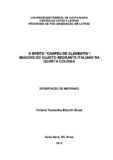| dc.creator | Brust, Viviane Teresinha Biacchi | |
| dc.date.accessioned | 2014-02-05 | |
| dc.date.available | 2014-02-05 | |
| dc.date.issued | 2013-02-25 | |
| dc.identifier.citation | BRUST, Viviane Teresinha Biacchi. The "Clementis hat" effect: images of the italian immigrant subject. 2013. 174 f. Dissertação (Mestrado em Letras) - Universidade Federal de Santa Maria, Santa Maria, 2013. | por |
| dc.identifier.uri | http://repositorio.ufsm.br/handle/1/9891 | |
| dc.description.abstract | The present work, entitled The Clementis Hat Effect: images of the Italian immigrant subject, has as main objective to consider the memory of the Italian Immigration in the Quarta Colônia through another discursive materiality, the monuments in honor to the immigrants, built from the 50th anniversary of their immigration. Considering these discourses, produced in determined socio-historical moments and in specific production conditions, we view identify possible taking of positions of this subject who sees in/through language, symbolic materiality, pass his question of belonging - or not to a new nation. We part from the metaphor constructed and analyzed by Jean-Jacques Courtine in which Clementis hat refers to memory that can be showed, but can also be erased and still return. In the permanency or not of a memory, power relations are established, ideological issues of the conflicts between symbolic and political, when the iron, wooden and wind languages articulate, acting as invisible barriers in the relation of the subject with the State. Therefore, we propose a sand language in which the memory of immigration remains, though fragmented and dispersed. In this way, through the analysis of the characterized subject position in relation to history and memory - which we denominate Clementis Hat we can identify: the utopia subject position when this subject is moved by the dream of the promised land, that is interrupted because of the immigration conditions; the cleavage subject position, when this subject abdicates their mother tongue and with/because of it, also their history; and the political subject position, where the subject negotiates his place with the State. Our theoretical-analytical movement is the anchor in the Discourse Analysis of French foundation and Brazilian continuity, which has its place in linguistics, historical materialism and psychoanalysis. It is with these fundamentals that we insert ourselves in the linguistic studies, in the line of research Language, Subject and History , where the subject, the discourse and the constitution of meaning is thought. | eng |
| dc.description.sponsorship | Coordenação de Aperfeiçoamento de Pessoal de Nível Superior | |
| dc.format | application/pdf | por |
| dc.language | por | por |
| dc.publisher | Universidade Federal de Santa Maria | por |
| dc.rights | Acesso Aberto | por |
| dc.subject | Língua | por |
| dc.subject | Sujeito | por |
| dc.subject | História | por |
| dc.subject | Memória | por |
| dc.subject | Imigração | por |
| dc.subject | Language | eng |
| dc.subject | Subject | eng |
| dc.subject | History | eng |
| dc.subject | Memory | eng |
| dc.subject | Immigration | eng |
| dc.title | O efeito "chapéu de Clementis": imagens do sujeito imigrante italiano na Quarta Colônia | por |
| dc.title.alternative | The "Clementis hat" effect: images of the italian immigrant subject | eng |
| dc.type | Dissertação | por |
| dc.description.resumo | O presente estudo, intitulado O efeito chapéu de Clementis : imagens do sujeito imigrante italiano, tem como objetivo principal pensar a memória da Imigração Italiana na Quarta Colônia por meio de outra materialidade discursiva, a saber, monumentos em homenagem ao imigrante, construídos na região a partir do cinquentenário da sua imigração. Considerando esses discursos, produzidos em determinados momentos sócio-históricos e em condições de produção específicas, visamos a identificar possíveis tomadas de posições desse sujeito que vê, na/pela língua, materialidade simbólica, perpassar a sua questão de pertencer ou não a uma nova nação. Partimos da metáfora construída e analisada por Jean-Jacques Courtine em que o chapéu de Clementis se refere à memória, a qual pode ser mostrada, mas pode também ser apagada e pode, ainda, retornar. Na permanência ou não de uma memória, estabelecem-se relações de poder, questão ideológica do confronto do simbólico com o político, quando as línguas de ferro, de madeira e de vento também se articulam, funcionando como barreiras invisíveis na relação do sujeito com o Estado. Diante disso, propomos a língua de areia, aquela pela qual a memória da imigração permanece, ainda que fragmentada e dispersa. Através das análises das posições-sujeito caracterizadas em relação com a história e a memória a que denominados de chapéu de Clementis identificamos: a posição-sujeito utopia, quando esse sujeito é movido pelo sonho da terra prometida, o que se interrompe dadas as condições da imigração; a posição-sujeito clivagem, quando esse sujeito é convocado a abdicar de sua língua e, com/por ela, da sua história; e a posição-sujeito político, posição essa do sujeito que negocia, com o Estado, o seu lugar. Nosso movimento teórico-analítico se ancora na Análise de Discurso de fundação francesa e de continuidade brasileira, a qual tem seu lugar no entremeio
da linguística, do materialismo histórico e da psicanálise. É com esses fundamentos que nos inserimos nos estudos Linguísticos, na linha de pesquisa Língua, sujeito e história , onde se pensa o sujeito, o discurso e a constituição do sentido. | por |
| dc.contributor.advisor1 | Silveira, Verli Fátima Petri da | |
| dc.contributor.advisor1Lattes | http://lattes.cnpq.br/4907455690392249 | por |
| dc.contributor.referee1 | Romão, Lucília Maria Sousa | |
| dc.contributor.referee1Lattes | http://lattes.cnpq.br/8828821460772801 | por |
| dc.contributor.referee2 | Zanini, Maria Catarina Chitolina | |
| dc.contributor.referee2Lattes | http://lattes.cnpq.br/4222381114451307 | por |
| dc.creator.Lattes | http://lattes.cnpq.br/7657921390114850 | por |
| dc.publisher.country | BR | por |
| dc.publisher.department | Letras | por |
| dc.publisher.initials | UFSM | por |
| dc.publisher.program | Programa de Pós-Graduação em Letras | por |
| dc.subject.cnpq | CNPQ::LINGUISTICA, LETRAS E ARTES::LETRAS | por |


